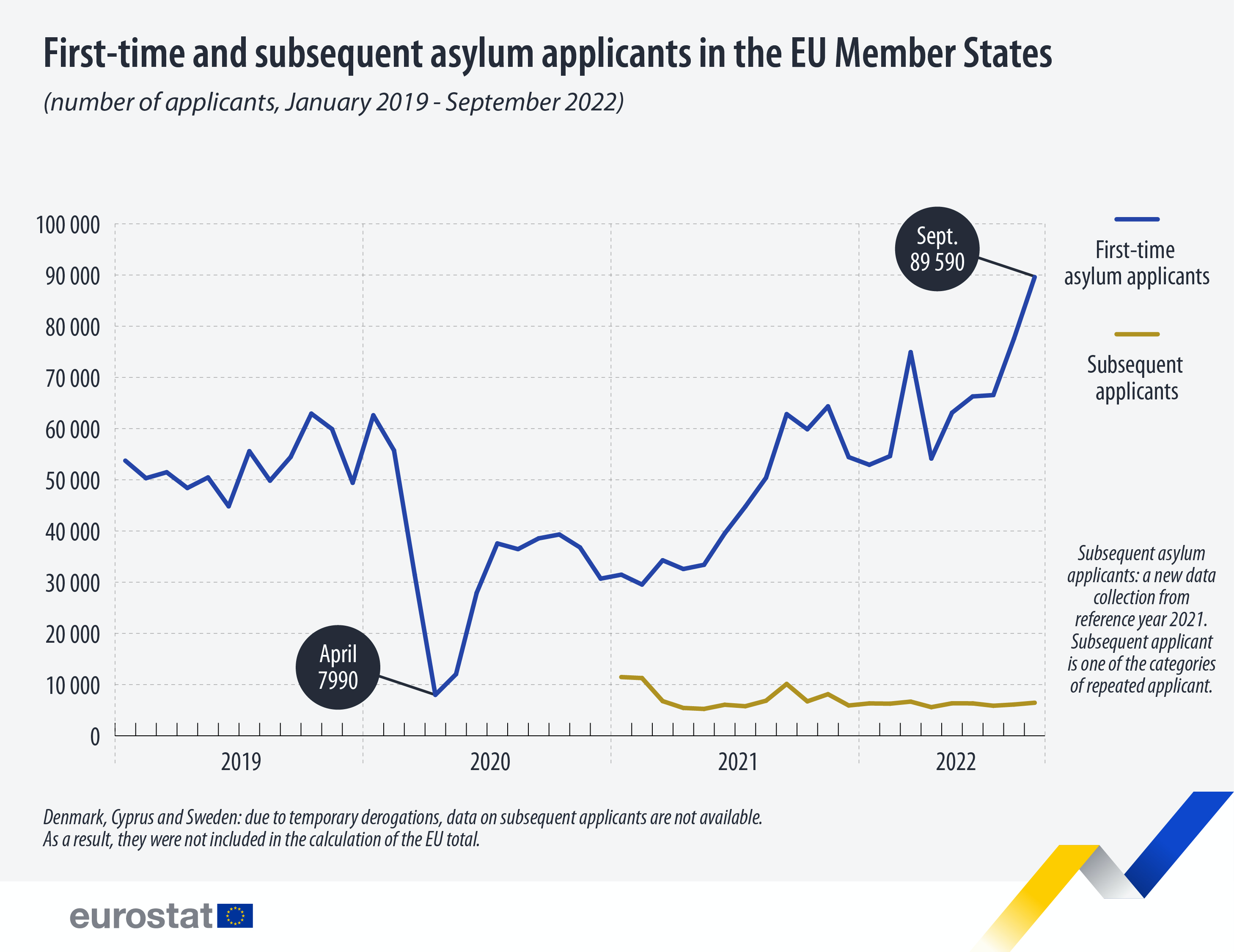First-time asylum applicants up 15% in September 2022

In September 2022, 89 590 first-time asylum applicants (non-EU citizens) applied for international protection in the EU Member States, 11 995 more people than in the previous month, an increase of 15%. Compared with September 2021 (62 820), there was a 43% increase in the total number of requests.
A similar increase was also registered in the number of subsequent applicants (people who reapplied for asylum after a decision had been taken on a previous application). In September 2022, there were 6 445 subsequent applicants, 345 people more than in August 2022, an increase of 6%. Compared with September 2021 there was a 36% drop.
This information comes from monthly asylum data published by Eurostat today. The article presents a handful of findings from the more detailed Statistics Explained article on monthly asylum statistics.
Source dataset: migr_asyappctzm
Most first-time asylum applicants were Syrians
Like in August 2022, in September, Syrians were the largest group of persons seeking asylum (14 930 first-time applicants). They were followed by Afghans (11 955), ahead of Turks (5 220), Indians (4 530), and Venezuelans (4 520).
Following Russia’s military aggression against Ukraine, there was a large increase in Ukrainian first-time asylum applicants (from 2 370 in February to 12 890 in March, but the numbers have been decreasing monthly (from 1 510 in April to 870 in September). This is also because people fleeing Ukraine benefit from temporary protection.
In September, the number of people from Russia applying for asylum for the first time also made the top 15 of citizenships, with 1 305 applications.
Germany continues to report the highest number of first-time asylum applicants
Since the beginning of 2022, Germany has been the Member State reporting the highest number of first-time asylum applicants in the EU. In September 2022, Germany received 18 715 first-time applicants, accounting for 21% of the total. Germany was followed by Austria (15 490, 17%), France (13 500, 15%), Spain (11 000, 12%), and Italy (7 920, 9%).
These five Member States together accounted for three-quarters (74%) of all first-time asylum applicants in the EU.
In total in the EU as a whole, there were 200 first-time asylum applicants per million population in September 2022.
Compared with the population of each Member State (on 1st January 2022), the highest rate of registered first-time applicants in September 2022 was recorded in Austria (1 725 applicants per million population), followed by Cyprus (1 714), Croatia (475) and Luxembourg (466). By contrast, the lowest rate was observed in Hungary (0.4).
Source dataset: migr_asyumactm
4 795 unaccompanied minors applying for asylum in the EU
In September 2022, 4 795 unaccompanied minors applied for asylum for the first time in the EU Member States, up by 8% compared with August 2022 (4 460). This is among the EU Member States for which data are available.
Most unaccompanied minors who lodged asylum applications in September 2022 came from Afghanistan (2 195), Syria (1 195) and Somalia (235).
The Member States that received the highest numbers of asylum applications from unaccompanied minors in September 2022 were Austria (2 070), Germany (535), and Belgium and the Netherlands (450 each). Although Austria and Belgium saw the number of requests increase by 10% and 7% compared with August 2022 respectively, Germany registered a 9% decrease and the Netherlands a 22% drop.
For more information
- Statistics Explained article on monthly asylum statistics
- Statistics Explained article on annual asylum statistics
- News article on Ukrainians granted temporary protection in October
- Thematic section on migration and asylum statistics
- Database on asylum statistics
Methodological information:
- Due to temporary derogations, data on subsequent applicants are not available for Denmark, Cyprus and Sweden, and on unaccompanied minor asylum applicants for France, Cyprus and Poland. As a result, these Member States were not included in the calculation of the respective EU totals. A complete list of such derogations is provided in the Commission Implementing Decision (EU) 2021/431.
- Statistics on asylum applicants considered to be unaccompanied minors presented in the article refer to the age accepted by the national authorities, however before the age assessment procedure was carried out/completed.
If you have any queries, please visit our contact us page.


